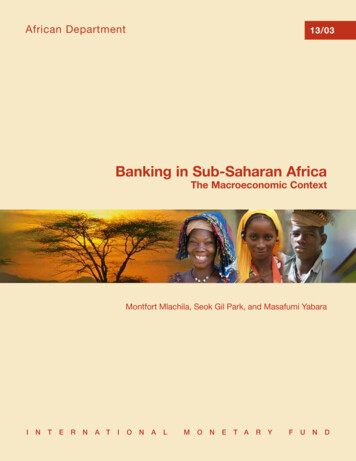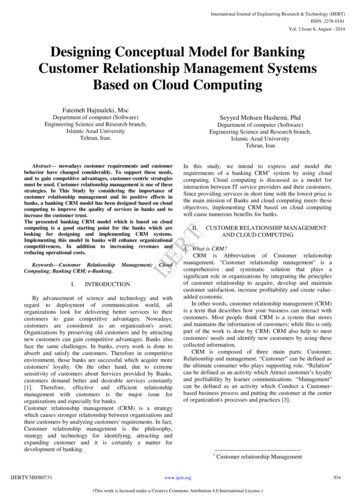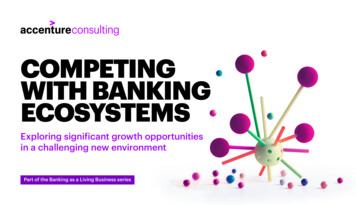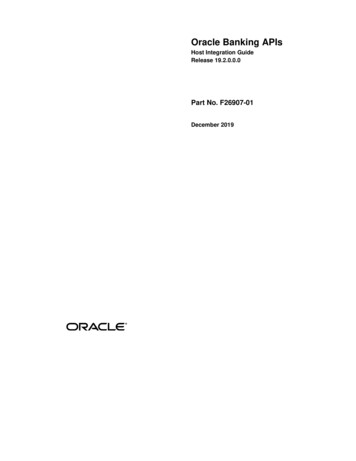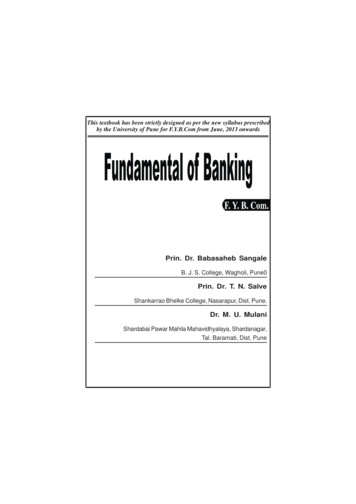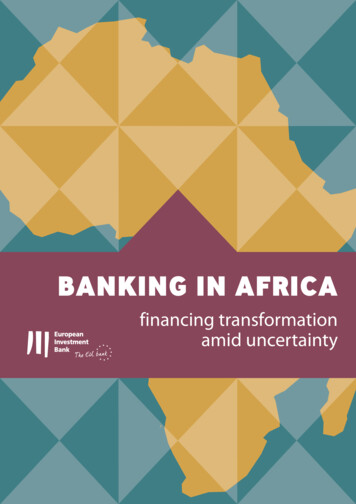
Transcription
BANKING IN AFRICAfinancing transformationamid uncertainty
ECONOMICS DEPARTMENTBanking in Africa:financing transformationamid uncertainty
Banking in Africa: financing transformation amid uncertainty European Investment Bank, 2020This is a publication of the EIB Economics ll rights reserved.All questions on rights and licensing should be addressed to publications@eib.org.European Investment Bank98-100, boulevard Konrad Adenauer – L-2950 Luxembourg 352 ankeBook: QH-02-20-012-EN-Epdf:QH-02-20-012-EN-NISBN 978-92-861-4493-6ISBN 978-92-861-4495-0doi: 10.2867/956074doi: 10.2867/306682About the reportThe Banking in Africa report is a product of the EIB Economics Department providing an analysis of recentdevelopment in the African banking sectors and specific structural topics of relevance. It combines in houseresearch with contribution from leading market experts from commercial banks operating in the region, IFIsand other institutions.About the EIB Economics DepartmentThe mission of the EIB Economics Department is to provide economic analyses and studies to support theBank in its operations and in the definition of its positioning, strategy and policy. The Department, a teamof 40 economists, is headed by Debora Revoltella, Director of Economics.Main contributors to this year’s reportReport Directors: Barbara Marchitto and Debora Revoltella.Report Coordinator: Jean-Philippe Stijns.Communication Editor: Daniel Berze, under the direction of Valentina Kalk, Head of Publications.Executive Summary:Chapter 1:Chapter 2:Chapter 3:Chapter 4:Chapter 5:Chapter 6:Chapter 7:Chapter 8:Chapter 9:Chapter 10:Debora RevoltellaJean-Philippe StijnsFrank Betz, Andreas Kappeler (European Commission) and Mohammed SalimBennani (BMCE Bank of Africa/Institute of Africa)Emmanouil Davradakis, Nina Fenton, Claudio Cali, Ismail Madih (BMCE Bank ofAfrica/Institute of Africa) and Joseph Nnanna (Development Bank of Nigeria)Jean-Philippe Stijns, Jad Benhamdane (BMCE Bank of Africa/Institute of Africa)and Said Hidane (BMCE Bank of Africa/Institute of Africa)Ricardo Santos, Jared Osoro (Kenya Bankers Association Centre for Research onFinancial Markets and Policy )Sanne Zwart and Stuart Theobald (Intellidex)Jean-Philippe Stijns, David Morgant, Guy Menant (Making Finance Work forAfrica), Arthur Minsat (OECD Development Centre) and Thang Nguyen Quoc(OECD Development Centre)Sanne Zwart, Giovanni Munoz, Lara Anna Chhatwal (GIZ), Bastian Domke (GIZ),Julia Kirya (GIZ), Hugues Kamewe Tsafack (Making Finance Work for Africa) andLisa Peterlechner (Consultant on behalf of GIZ)Nina Fenton, Christoph Weiss, Jason Gagnon (OECD Development Centre) andLaura Wollny (Paris School of Economics)Nina Fenton
AcknowledgementsEditing: Linguistic Services, European Investment Bank and SciencePodCoordination: Nathalie Gilson, Senior Operational Assistant, European Investment BankPamella Ahairwe, Federica Ambrosio, Richard Amor, David Ashiagbor, Moutalabi Baba Boukari, DieterBachlmair, Rafal Banaszek, Marc Bello, Tim Bending, Maya Berger, Rhoda Boadu, Federico Bonaglia, AntoninCalzarossa, Calliope Chalouva, Carmelo Cocuzza, Douglas Daura, Angus Downie, Karla Fallon, Sebastien Hay,Peter Haynes, Laurie Henkinbrant, Oliver Henniges, Claudia Huber, Hans-Harald Jahn, Zoe Jankel, SaliyaKanathigoda, Xenia Kanelliadou, Sabine Kayser, Yves Kra, Sónia Leonardo, Filipe Marques, ImmaculadaMartinez, Hugh McCormack, Hekkn Meijez, Arnaud Mertens, Céline Micard, Kristina Mikulova, NikosMilianitis, Samuel Miquel, Gerry Muscat, Moussa Nakoulima, Faith Njoroge, Azande Ntanzi, Nicholas Nzioka,Tomek Olejnik, Alexandre Pegels, Adeline Pelletier, Sonia Plaza, Brian Power, Dilip Ratha, Walid Remmache,Eva Rømer, Robert Schofield, Markus Schulte, Inmaculada Soto Riba, Lilian Steinhäuser, Mamoun TahriJoutei, Tomas Tamosauskas, Sabine Tissot, David Verhofstadt, Jens Windel, Peter Zajc.DisclaimerThe views expressed in this publication are those of the authors and do not necessarily reflect the positionof the EIB.
CONTENTSExecutive summary . 11.Results from a survey of African banking groups . 55552.Banking in North Africa: recent trends and developments . 3333.Banking in West Africa: recent trends and developments . 51514.Banking in Central Africa: recent trends and developments . 735.Banking in East Africa: recent trends and developments . 1016.Banking in Southern Africa: recent trends and developments . 1177.Investing sustainably in Africa’s cities . 1378.Mobilising agricultural value chain financing in Africa: why and how . 11599.Remittances and financial sector development in Africa. 18310. The European Investment Bank in Africa . 205
Executive summaryThis fifth full edition of the European Investment Bank’s study of banking sectors in Africa casts light onrecent developments in the continent’s banking sectors and the policy options for all stakeholders. Thechapters devoted to banking sector development in each sub-region have been enhanced compared toearlier editions, with greater focus being placed on micro, small and medium-sized enterprises (MSME) andon financial inclusion. Another objective of the 2020 edition of this study is to contribute to the EIB’s AfricaDay on 27 February 2020 in Dakar, Senegal, in partnership with UN Habitat.In Africa, real GDP growth is set to remain relatively resilient despite persistent uncertainty in the globaleconomy. Economic growth is projected to accelerate moderately in 2020, due to strengthening demand,but it is expected to be held back on a longer-term basis by the slowing pace of reforms. The populationgrowth rate means that GDP per capita will increase less than needed to ensure fast convergence withmiddle- and high-income economies, to make a significant dent into poverty and create enough jobs for thegrowing labour force. Inflationary pressures have eased and the average current account and governmentdeficits are projected to decline, reflecting the recovery of commodity prices since their 2016 low and, insome countries, fiscal consolidation. The average debt situation of African countries shows signs ofstabilisation, but there is a high risk of debt distress in several countries due to the high level of governmentdebt, particularly non-concessional debt, and rising debt-servicing costs. There is a significant degree ofheterogeneity across countries regarding the pace of recovery, medium-term prospects and debtsustainability.The economic performance of North Africa is improving. The economies of the region are expanding andGDP growth is expected to accelerate to 4.4% in 2020 and 2021. For some time, restoring macroeconomicstability was a primary concern for the national authorities. More recently, however, reforms to promoteprivate sector development have been implemented.In the WAEMU zone, the economic outlook remains resilient. Real GDP growth is set to increase to 6.5%in 2020 from 6.4% in 2019 and to average 6.8% over 2021-2024. Growth in private investment and anincrease in agricultural productivity are expected to sustain economic activity over this period. There is arisk of fiscal slippages ahead of the forthcoming elections in several countries in the WAEMU zone.The outlook for West African countries outside the WAEMU zone is mixed. The region’s largest economy,Nigeria, which accounts for two thirds of West Africa’s GDP, is expected to grow at around 2.5% in 2020.Growth rates are expected to average 2.6% over 2021- 2024. Ghana, on the other hand, is expected to growat 5.6% in 2020, but faces a risk of fiscal slippage ahead of the 2020 elections. The main downside risks forthe sub-region stem from significant uncertainty in the global economy and escalating trade protectionism,including in the region. The Nigerian economy remains highly vulnerable to any drop in oil prices.There has been a notable acceleration in economic activity in the Central African Economic and MonetaryCommunity (CEMAC) zone. Economic growth is projected to reach 3.0% in 2020 in the CEMAC. The IMFprogrammes agreed with all countries in the region are bearing fruit but the improvement in the fiscalsituation comes against a background of many external risks that might undermine a scenario of gradualacceleration in growth.Economic growth is expected to remain solid across East Africa. GDP growth is expected to accelerate to6% in 2020 and 2021, above the average of sub-Saharan Africa (SSA), as infrastructure investments acrossthe region give an extra boost to domestic demand. Still, risks to the outlook are tilted to the downside,mostly stemming from potential external shocks.Economic developments in Southern Africa in recent years have generally been characterised by lowgrowth. Growth in the sub-region remained subdued during 2019 but is expected to pick up to 1.6% in 2020,although domestic and external risks to this outlook remain substantial. The high level of public debt leavesa number of states vulnerable to external shocks and reduces or even blocks access to external financing.Executive summary1
In line with the generally improving economic conditions in most African countries, the banking groupssurveyed for this report are generally in expansionary mode, mostly thanks to organic growth but alsodue to greenfield and brownfield investments. Nevertheless, some groups are still in consolidation mode,especially in the short term. The banking groups report improvements in terms of loan origination andfunding conditions. Non-performing loans (NPLs) appear to be coming under control in most banking groupsbut they are still on the rise in others. Efforts to comply with Basel II and Basel III standards are also reported.In terms of products and service focus, African banking groups are still emphasising investment in e-bankingand mobile banking services. Some groups are also deploying or planning the development of fintech, withthe main focus on facilitating mobile money, electronic transfers and back-office operations. A considerableproportion of groups are also investing in lending-related fintech, including data analytics and blockchaintechnology. The situation of African countries is also heterogeneous in terms of financial marketdevelopment and the degree of advancement of financial inclusion.Financial inclusion in North Africa is more advanced than in many other regions on the continent. Thefinancial sectors in the region are dominated by banking activities. Banks, in turn, are well developed, andsome have a pan-African vision. The sub-region’s banks have started to offer non-financial services to SMEs,micro-firms and start-ups, which can improve the management practices of firms, and thereby promoteentrepreneurship and innovation. Access to finance can be further improved by reforming the institutionalframework governing secured lending and by developing non-bank finance. Reform of secured transactionframeworks would benefit both banks and firms. Such a reform would make it easier for firms to pledgemovable assets as collateral. This would help SMEs in particular, as they are more likely to lack high-qualitycollateral.Despite improvements in the soundness and stability of West African banking systems, access to financeremains a challenge across West Africa. The banking sector in the West Africa Economic and MonetaryUnion (WAEMU) remains sound and profitable, while Basel III capital requirements are being implemented.The profitability of Nigerian and Ghanaian banks remains adequate, thanks to high interest rate spreads andhigh yields on government securities. Soundness and stability are also improving in these markets, with nonperforming loans declining and capital adequacy improving. Progress has been particularly marked inGhana, where the central bank led a process of reform and consolidation, reducing the fragmentation ofthe banking sector. Access to finance is still the most commonly cited constraint in more than half of thecountries in West Africa, followed by political instability and practices in the informal sector. Banks considerlending to SMEs highly risky and ask for significant levels of collateral, while a significant portion of theirinvestment is allocated to government assets.The balance sheet activity of the banking sector in the CEMAC zone has improved significantly, owing tothe economic recovery. However, the quality of the zone’s credit portfolio still calls for vigilance. Thesector’s prudential situation has improved slightly, thanks to banks’ capitalisation efforts. The regulatoryand prudential arsenal continues to be changed and adapted but the banking sector continues to bepredominant in the financial activity of all CEMAC countries. Businesses are using banking services less inCEMAC countries than in the rest of Africa. Some efforts are expected to strengthen banking infrastructurein the zone that will, in turn, ease SMEs’ access to corporate financing. On the other hand, financial inclusionis experiencing very strong growth in CEMAC countries, thanks in particular to the advent of mobile banking,even though there is still significant room for improvement. In the Democratic Republic of the Congo (DRC),although banking activity is developing well, the quality of assets calls for caution. Bank account penetrationstill has a long way to go to contribute to the country’s economic diversification and to make growth moreinclusive. A series of regulatory reforms could lead to profound changes in the sector.The financial sector in East Africa remains stable. In the past two years, a favourable economic outlook andregulatory developments have underpinned the performance of the banking sector in East Africa. Theimprovement in economic activity in 2018 and 2019 dispelled some of the fears that followed thedeceleration in previous years. Going forward, the performance of the regional banking sector will continueto depend on the extent to which the banks address not only the downside risks to the economic outlook,but also the challenges related to regulation and digitalisation. Financial inclusion has improved moresignificantly in East Africa than in other regions, but access to finance still remains the main bottleneck forcompanies throughout the region, although less so in the bigger economies. This is particularly the case for2Banking in Africa: financing transformation amid uncertainty
SMEs and micro-enterprises. In some countries, the fact that the local banking sector is keen to mainly lendto the public sector is resulting in less finance available for the private sector. Mobile accounts and financialinclusion are improving unevenly across the region. Despite generalised access in countries such as Kenya,in some countries still less than 5% of the population uses digital banking or payment systems.Southern Africa’s banks generally have good capital and liquidity positions, which are closely linked totheir conservative risk appetite and management. Although banking sectors vary widely across the region,some themes of recent years cut across borders. Firstly, the weakening of government finances in severalcountries puts pressure on the sector as banks have had to fund budget deficits, sometimes at the expenseof lending to the private sector. Secondly, the weak economic performance has fed an increase in nonperforming loans in most markets. Thirdly, banking supervision and regulation are improving. Fourthly,concerns regarding anti-money laundering and combating of terrorist financing have triggered a decline ininternational correspondent relationships, which has reduced the region’s access to the internationalfinancial system. The outlook for the banking sector is generally positive, reflecting the cautious recovery,but SMEs will continue to face bottlenecks when looking for financing due to high interest rates and strictcollateral requirements. Larger firms typically find it easier to arrange credit, and the difference withrespect to smaller firms is particularly pronounced in Lesotho, Malawi, Namibia and Zambia. Creditconstraints are loosely linked to the development of the financial sector, as countries such as Botswana,Mauritius and South Africa have a lower share of credit-constrained firms. This link is confirmed whenconsidering the population’s access to finance.This year’s report touches on three important thematic issues of cross-cutting importance in Africancountries. Firstly, the report explores policy options to finance urban development in the context of fastexpanding African cities. Secondly, the financing of Africa’s agricultural value chains is discussed. Finally, thereport examines how remittances can be harnessed to boost financial sector development.Adopting a territorial and inclusive approach is key to unleashing the potential of urbanisation in Africa.The lack of effective urban planning has long been the root of the uncontrolled development of Africancities and of higher investment costs for infrastructure and services. In particular, secondary cities areexpected to play a special role in eradicating poverty, facilitating structural transformation and unlockingthe potential of Africa’s agricultural value chains. Inclusive approaches that secure the involvement andbuy-in of all stakeholders, including the population, can generate smart solutions, resilience, and cost andenergy efficiency. Building climate change resilience in urban areas requires a holistic, comprehensive andmulti-sectorial/dimensional approach. Social and affordable housing is a key sector for sustainableurbanisation and African authorities and local financial intermediaries have a critical role to play. Inefficientland allocation systems are fuelling conflict due to the general inability to properly allocate and manageland rights and interests. Successful African examples of land reforms and land title systems exist and canserve as a benchmark. They can have significant cross-cutting effects on the business environment.Well-structured agricultural value chain financing can boost agricultural productivity, thereby supportingsustainable economic development in Africa. Agriculture is a key sector of economic activity in the region,as shown by its large contribution to GDP and its high employment share. Raising productivity along thevalue chain would help end hunger and malnutrition and meet growing food demands. It would alsoincrease the incomes of the often poor smallholder farmers and enable the export of products that are lessprice-sensitive and more profitable. However, a considerable financing gap holds back agriculturaldevelopment as lending to the agricultural sector is often deemed particularly risky. The perceived high riskscan be mitigated by well-structured agricultural value chain financing (AVCF). The success of AVCF dependsin particular on getting the right expertise and partners, creating the right structures and procedures,tailoring financial products to the specific needs of farming activities, the upstream and downstream sectorsof agriculture, training farmers and building trust, and fostering the smart use of digital solutions. Thesefactors all help reduce risks and lower transaction costs, thereby making AVCF work for providers of financeand their users.Remittances are already a crucial source of external finance for many African countries. Furthermore, thelarge numbers of African citizens living and working abroad, both on the continent and elsewhere, suggestthat there is potential for remittances to become an even more effective driver of economic and socialdevelopment on the continent. However, the impact of remittances depends on how they are used, andExecutive summary3
particularly on the extent to which they are channelled towards productive investment. This depends inturn on financial sector development. In some African financial sectors, the positive impact of remittancesis hindered, the costs of remittance services are high and migrants are incentivised to channel funds throughinformal channels. Some measures to enhance financial sector development can boost the developmentimpact of remittances. For example, developing payment systems and promoting competition in remittancemarkets could bring down the costs of sending remittances and encourage remitters to use formal channelsto send funds. New technologies and the use of mobile money systems can also help bring down costs, butcountries need to put the appropriate frameworks in place to facilitate the use of these technologies whileat the same time mitigating risks.The first part of this report represents a study of the banking sectors across Africa. The second partconsists of thematic chapters that address transversal challenges and opportunities with regard tofinancing investment in Africa. Chapter 1 reports on the responses to a survey of banking groups in Africa.Chapters 2-6 examine recent trends in the banking sectors in, respectively, Northern Africa, West Africa,Central Africa, East Africa and Southern Africa. Chapter 7 concerns the opportunities and challengesassociated with investing sustainably in Africa’s cities, to set the scene for discussions during and after theconference. Chapter 8 analyses how well-structured agricultural value chain financing can boost agriculturalproductivity, thereby supporting sustainable economic development in Africa. Chapter 9 discusses howremittances can become an even more effective driver of economic and social development on thecontinent. The study ends with a chapter summarising how the EIB has been investing in sustainabledevelopment across Africa since 1963, explaining the type of financial support and technical assistanceoffered by the EIB to financial sectors on the continent and briefly exploring the way forward.Debora RevoltellaDirector, Economics DepartmentEuropean Investment Bank4Banking in Africa: financing transformation amid uncertainty
11Results from a survey ofAfrican banking groupsJean-Philippe Stijns11Senior Economist, European Investment BankThe author would like to thank Angus Downie, Yves Kra, Guy Menant, Adeline Pelletier and EIB colleagues, including EmmanouilDavradakis, Barbara Marchitto, Samuel Miquel, Debora Revoltella, Robert Schofield and Sanne Zwart, for the comments this chapterhas benefited from. The author is also grateful to the editors who have provided valuable feedback on earlier versions of this chapter.However, the views expressed here are those of the author and do not necessarily reflect those of the European Investment Bank. Allremaining errors are the responsibility of the author.Results from a survey of African banking groups5
SummaryThis chapter takes stock of trends and strategic issues affecting banking groups in Africa, basedon the results of the fourth edition of the European Investment Bank’s survey of banking groupsin Africa (see Appendix 1). Our survey’s coverage has been extended to include the whole Africancontinent, and the sample size has been increased in this edition from 25 to 46 banking groupsoperating in Africa. The 2020 sample of banking groups is composed of a mix of pan-African banks,sub-regional banks, foreign banks operating in Africa and national banks. A continental approachhas the advantage over a regional approach of better encompassing banking group relationshipsthat span multiple sub-regions. The overall message coming out of responses to this year’s surveyis one of cautious optimism about a gradual return to growth and stability in African bankingmarkets.In line with the generally improving economic conditions in most African countries, most groupsare in expansionary mode, mostly thanks to organic growth but also due to greenfield andbrownfield investments. Nevertheless, some groups are still in consolidation mode, especially inthe short term. The banking groups report improvements in terms of loan origination and fundingconditions. Non-performing loans (NPLs) seem to be coming under control in most banking groupsbut they are still on the rise in some groups. Efforts to comply with Basel II and Basel III standardsare also reported.The groups are planning to expand their loan books, identifying manufacturing and agricultureas their top sectoral focuses at the moment. In addition, most banking groups report putting avery high priority on SME financing as a growth area. However, the banking groups identify somespecific constraints to lending to SMEs: a shortage of bankable projects, a lack of effectivecollateral, a lack of managerial capacity, informality and a high default rate amongst SMEs. Mostbanking groups consider portfolio guarantee products as important but, unfortunately, guaranteeneeds are still predominantly unmet. Similarly, banking groups report a strong demand for localcurrency financing. Some groups also report that their most important technological needsconcern credit risk management and lending technology.In terms of products and service focus, African banking groups are still emphasising investmenton e-banking and mobile banking services. Some groups are also deploying or planning thedevelopment of fintech, with the main focus on facilitating mobile money, electronic transfersand back-office operations. Banking groups view telecom companies primarily as partners ratherthan as competitors for the provision of mobile money services. It is commercial banks thatbanking groups consider as their most direct competition. A fair proportion of groups are alsoinvesting in lending-related fintech, including data analytics and blockchain technology.6Banking in Africa: financing transformation amid uncertainty
IntroductionThis chapter takes stock of strategic issues affecting banking groups in Africa and attempts to provide asnapshot of banking sectors. The analysis relies on the results of the fourth edition of the EIB’s survey ofbanking groups in Africa. For this purpose, an attempt is made to reflect in our sample the wide variety ofbanking groups operating in Africa’s banking markets. Three groups of foreign banks competing in theregion can be distinguished: foreign affiliates of global banks from developed countries; foreign affiliates ofbanks from emerging countries, in which we can include the foreign affiliates of banks from South Africa;and foreign affiliates of regional African banks (multinational banks from Africa). The term pan-Africanbanks is used when grouping banks operating across several African markets, based in an African country,including South Africa. Regional African banking groups are headquartered in a variety of countries andsome enjoy a significant presence in a large number of countries.The EIB survey questionnaire and its sample of banking groups are in their fourth edition in Africa thanksto the ongoing collaboration of many banking groups, national, regional and global. A first pilot edition ofthe survey was launched in 2015 (European Investment Bank, 2015) covering pan-African banks operatingin sub-Saharan Africa (SSA). The second edition of the survey (European Investment Bank, 2016) wasexpanded in two ways. First, the sample of banking groups that agreed to participate in the survey grewfrom 10 to 17 banks and it included some global banks with a wide footprint in SSA. Second, the number ofquestions put to banking groups was expanded from 10 to 20 questions, covering an enhanced set ofstrategic issues, including demand and supply of local currency loans and technological deployment. Weestimated using BankFocus data that these 17 banking groups (and their African subsidiaries) representedon average around a third of total assets in SSA (including South Africa) over the 2006-2015 period. In thethird edition of the survey (European Investment Bank, 2018), the sample of banks and the questionnairewere further expanded, with a net gain of eight banks. An effort was also made to broaden the sample toinclude a larger number of African regional banks. The result was a sample comprising 25 banking groups.The number of questions increased from 20 to 25, with new questions focusing on SME lending, fintech,collaboration between banks and telecom companies, banks’ competitors, regulatory capital, subordinateddebt and strategic sectors for lending.For this fourth, 2019 enhanced edition, the geographical coverage of the survey was expanded to thewhole African continent and some of the questions were enriched and fine-tuned. This helped to bringthe number of banking groups participating in the survey from 25 to 46. The intent is to match thegeographical coverage of the overall report this chapter is published in, and of the EIB’s Africa Day, theannual event where the report is launched and discussed. Obviously, a continental approach also has themajor advantage of better encompassing the banking groups that are more and more joining the bankingsectors of Africa’s sub-regions. Finally, many of the market dynamics, challenges and opportunitiescharacterising North African banks are relatively similar to those of their southern neighbours. This isconfirmed by the fact that extending the survey’s coverage to the whole continent has not altered the mainstructural observations made in the earlier editio
Economic growth is expected to remain solid across East Africa. GDP growth is expected to accelerate to 6% in 2020 and 2021, above the average of sub-Saharan Africa (SSA), as infrastructure investments across the region give an extra boost to domestic demand





